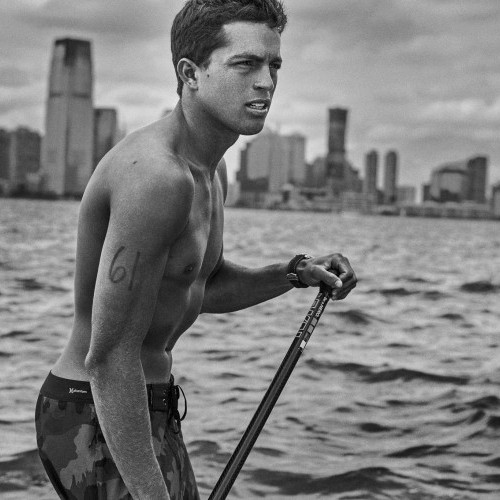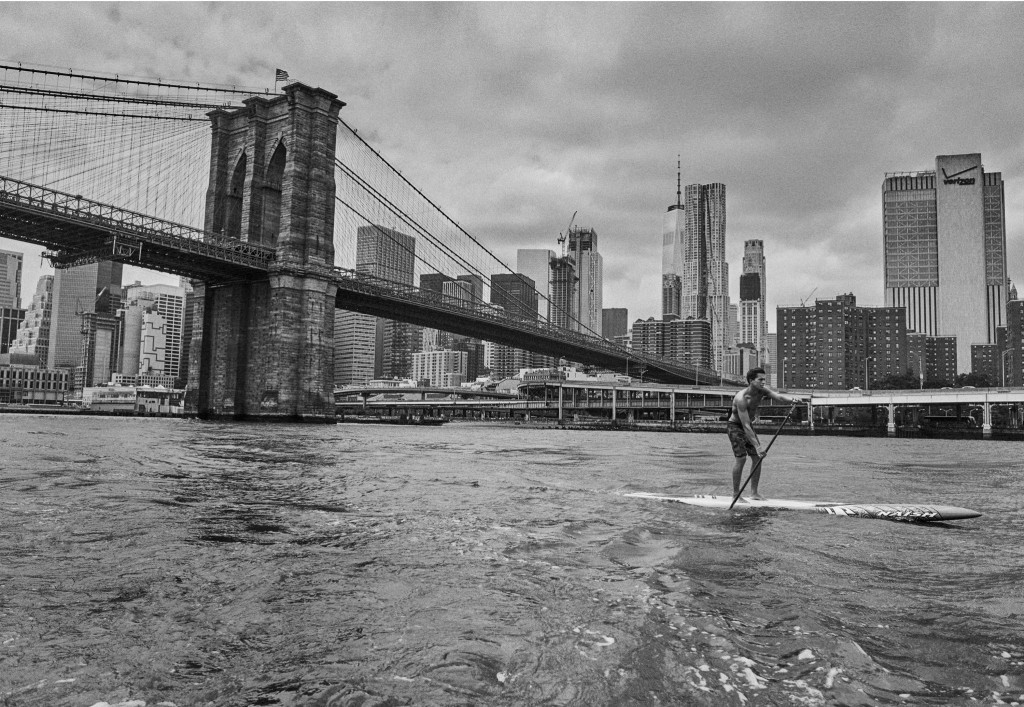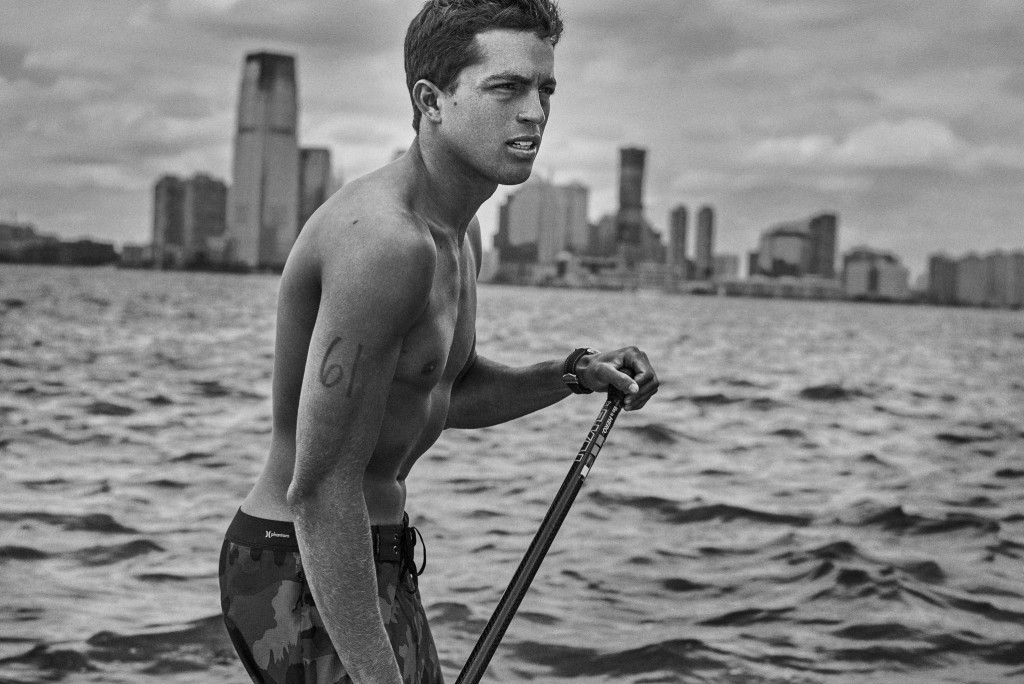
Kai Lenny’s Red Bulletin Cover
Sat 21st Oct, 2017 @ 3:00 am
When it comes to wave riding — on a surfboard, windsurf, kite, or SUP — Kai Lenny is a force. At just 25 years of age, Lenny has not only dominated existing disciplines but he’s also pioneered a new discipline: foil riding. Kai Lenny is the cover story of The Red Bulletin’s November issue. Enjoy an excerpt from the story, below, about Kai’s rise, his drive, and the plans he has to ride waves such as Nazaré in Portugal on a foil.
What happens when you’re one of the best in the world at every existing board-related discipline? You resurrect another one. Why Kai Lenny is set to redefine what we believe is possible in the water.
Lenny, if you’re not familiar, is perhaps the best “waterman” in the world at the moment and already one of the most accomplished, despite being only 25 years old. He is a seven-time SUP world champion and runner-up at the 2013 Kite Surf Pro World Championships and would have been among windsurfing’s elite had he focused on it. He surfed Maui’s fearsome big-wave cathedral Jaws at 16, became the first person to windsurf across Lake Michigan at 19 and in 2016 won the grueling 32-mile Molokai to Oahu open-water ocean SUP race, smashing the record in the process.
A week before New York, Lenny stopped in Puerto Escondido, Mexico, where he won his first-ever World Surf League Big Wave Tour event, on an “unconventional” board that he designed — using elements of windsurf and paddle boards, plus the bottom of a water ski — but had never before ridden in big surf. “It almost looks like it shouldn’t work, and that it would be terrifying, but it ended up being magic,” he says.
Lenny is disarmingly mild- mannered. He could not seem less amped when you encounter him on dry land. He says that people are constantly surprised that he’s not huge and jacked, because they see him on film, charging huge surf, and perspective is difficult. “He’s the nicest guy you’ll ever meet and totally comfortable in his own skin but secretly a madman in big waves and one of the fittest people on Earth,” says Kelly Slater.
Funny thing about Lenny’s win in Mexico: He almost didn’t show up. Big-wave comps cannot, by nature, be scheduled. They have windows, and they either happen or don’t, depending on whether Mother Nature brings the fury. And this one clashed exactly with the Molokai ocean race, which Lenny very much wanted to run—but not to defend his title. He wanted to do it on a foil, because no one else had, even if it meant his time would not count. Organizers said no. So he went to Mexico. And won.
Thus, in the course of 10 days, Lenny bailed on an epic ocean race (in which was defending champion) because they wouldn’t let him do it on a foil and instead went to Mexico and won a WSL Big Wave competition on an experimental board, after which he flew to New York City to paddle 25 miles around Manhattan in four hours. Such is the life of Kai Lenny, waterman extraordinaire.
Into his early teens, he competed in numerous sports, but people kept telling him he’d eventually have to focus. “I remember him saying, ‘Dad, I love them all.’ ” Martin Lenny says. Instead of wondering what Lenny might be capable of if he stuck to one thing, the question we should be asking is: What is Kai Lenny capable of, period?
Kai Lenny’s parents, avid windsurfers who met and fell in love on Maui, passed on their obsession with wind and water to their son. He began surfing at 4, windsurfing at 6 and foiling at 9. He would, his mom recalls, make miniature windsurfers at night, using scraps given to him by sailmakers for sails and chopsticks for masts. His parents still have a sketchbook filled with his drawings of boards and sails, as well as drawings of his hero, the windsurfing legend Robby Naish, winner of 24 world titles. At 9 years old he wrote a letter to Naish asking him for sponsorship and, to his parents’ surprise, Naish took him up on it. Other sponsors soon came calling too, including Red Bull, which signed him at age 11.
Laird Hamilton may be the only other superstar athlete whose career compares to Lenny’s, in that he too has eclectic interests and defies traditional definitions of what it means to be an elite professional.
And, indeed, Hamilton was one of his mentors—an idol, Martin says, from the time Kai was a young child. Laird and Dave Kalama, another big- wave legend, were the ones who took him to Jaws for the first time when he was 16 years old.
“Kai is really good, but he is also very lucky,” says Robby Naish. “He was raised on the north shore of Maui, surrounded by world-class athletes, provided with unlimited free equipment, home-schooled so that he could spend as much time on the water as possible. The opportunity was handed to him on a silver platter. But he appreciated those opportunities: He listened, he has stayed focused, he trained, he avoided distractions and he got better and better. A lot of other kids would have wasted the opportunity.”
This is what distinguishes a special athlete from those who are merely talented. Lenny was obsessed and willing to work for it, which is why no one should dismiss what he’s doing with foils.
These funky board attachments first appeared back in the late 1990s, when Hamilton and Kalama took the foils from a quirky ski-boat toy known as the Air Chair and put them on surfboards. They wore snowboard boots, strapped themselves into homemade bindings and towed each other into waves on the foils, reaching insane speeds and generally blowing minds with video clips.
But the concept never took off, and foiling remained a niche until Lenny started playing around with it a few years back. He asked Naish to make a foiling board but his company couldn’t spare any engineers. So Lenny found his own on Maui and began to tinker with versions that didn’t require bindings and could work in mushy conditions at low speeds.
“Their purpose originally was for riding the biggest waves ever ridden, ’cause it could cut through the chop and go fast,” he says, wandering Manhattan’s far West Side in search of food to help replace the bazillion calories he’d burned during the race. “But when I got my hands on one I went the exact opposite direction. Instead of trying to ride the world’s biggest waves, I thought, what about riding the world’s smallest waves? What about the worst waves in the world?” The original foils required epic conditions. “If the waves are small and terrible, like everywhere in the world, those foils wouldn’t have worked.”
“Foiling took conditions that previously were bad and turned them insane,” Lenny says, dodging groups of tourists taking selfies. “As a professional athlete, I’m used to doing all these sports at the highest level, but there were conditions where I couldn’t do that. Foiling filled that void.”
It’s not just that, though. There’s also the feel, the sensation. “The best way I can compare hydrofoiling to anything would be snowboarding in chest-deep powder,” Lenny says. “You’re on this tiny little board and you’re just free. You feel like you’re flying.”
Lenny has since gotten many of the world’s best surfers onto foils, including big-wave star Ian Walsh, current World Surf League champ John John Florence and Slater, the greatest surfer in history. “Even though it’s kind of an old sport, it’s brand new,” he says. “I would say its birth was pretty much two years ago.”
For now, Lenny seems to have run out of things to put foils on. It’s more a matter of refining. More and more, he’s been way off shore, out in the open water. “There’s a lot of potential to ride crazy swells in the middle of the ocean,” Lenny says. He’s already foiled most of the open water between the Hawaiian islands, by riding a swell until it runs out of power and then hopping to another one. The longest stretch, from the Big Island to Maui, was 50 miles. Lenny says he “felt great” at the end, and that he could have kept going, but he thinks that foils still need to evolve further before he tackles truly long distances. “You could do the entire Pacific,” he says. “But physically, I don’t know if it’s possible.”
Lenny is very much involved in the design of his foils. “I would say my knowledge of physics has gone up since high school,” he says. He’s become an amateur expert in hydrodynamics and has the ability to translate his experiences—what he’s feeling on a board—into words so that the naval engineers who work on his foils can tweak the designs.
A truly effective big-wave foil is something he has yet to master. Some might argue that epic waves the size of buildings obviate the need. Oh no, Lenny says. Certain waves—Portugal’s Nazaré, for instance—are ideal for foils. “The problem with a normal surfboard is you can’t get to the bottom of the wave quick enough. You get swallowed by the avalanche.” With the foil, however, a surfer can fly down the face of a wave, getting ahead of that avalanche.
Also, not all big waves break. There are enormous 100-footers out there in the world’s oceans—roaring mountains of water that never break and are impossible to surf. Unless you’ve got a foil. Lenny’s working on a version for these waves. He’s been out in big surf, “but nothing gigantic yet.” By winter, he thinks, he’ll be ready.













